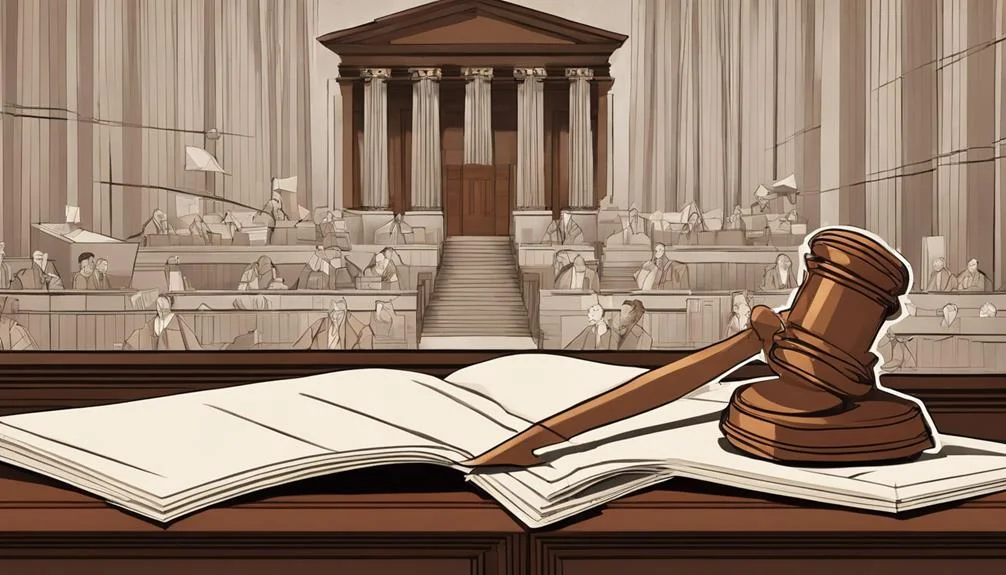The pros of judicial activism are that it champions civil rights, social justice, aligning laws with modern societal values. It ensures the legal framework remains relevant by reinterpreting outdated laws progressively, adapting to new ethical standards. Judicial activism catalyzes legal progress, reflecting societal trends, facilitating necessary changes often delayed by the legislative process.
The cons of judicial activism include eroding public trust through excessive court interventions, undermining the foundational rule of law. It challenges the separation of powers, allowing judges to override legislative intentions, unsettling the checks and balances system. By bypassing the democratic process, it diminishes the power of elected officials, leading to decisions that may not align with the majority’s will, threatening democratic principles.
Takeaways:
- Judicial activism promotes the protection of minority rights and counters government overreach.
- It plays a crucial role in driving social change and upholding constitutional principles.
- Critics argue it grants excessive power to judges, potentially based on personal biases.
- Concerns include undermining the separation of powers and creating legal uncertainties.
| Pros of Judicial Activism | Cons of Judicial Activism |
|---|---|
| Promotes Civil Rights and Social Justice | Undermines Elected Officials’ Power |
| Protects Individual Rights | Violates Checks and Balances |
| Makes the Law Fairer | Potentially Leads to Anarchy |
| Facilitates Legal Progress | Bypasses Democratic Process |
| Enhances Democracy | Promotes Government Overreach |
| Provides Checks and Balances | Influenced by Personal Beliefs |
| Encourages Legal Debate | Questions Regarding Validity |
| Addresses Urgent Issues | Blurs the Lines Between Branches |
| Promotes Equality | Life Tenure Issues |
| Adapts to Social Changes | Lack of Consistency |
Pros of Judicial Activism
- Promotes Civil Rights and Social Justice: Judicial activism plays a critical role in advancing civil rights and social justice by addressing issues that may be overlooked or avoided by the legislative and executive branches. For instance, landmark decisions in the United States, such as Brown v. Board of Education, were pivotal in desegregating schools, showcasing how judicial activism can correct systemic injustices that persist despite existing laws.
- Protects Individual Rights: By allowing judges to interpret the law broadly, judicial activism ensures the protection of individual rights against the majority’s will. This approach has been instrumental in cases where legislative bodies were hesitant to act, ensuring that minorities and other vulnerable groups receive protection under the law.
- Makes the Law Fairer: Judicial activism allows for a dynamic interpretation of the law, making it adaptable to changing societal values and norms. This flexibility ensures that outdated or unfair laws can be reinterpreted in light of contemporary standards, ensuring justice is served in a modern context.
- Facilitates Legal Progress: Through judicial activism, courts can lead the way in legal innovation, setting precedents that inspire new legislation or the amendment of existing laws. This proactivity can accelerate progress in areas such as environmental protection, where urgent action is needed but legislative processes are slow.
- Enhances Democracy: Judicial activism can strengthen democracy by ensuring that the rights of minorities are protected. By guarding against the tyranny of the majority, judicial activism ensures that all voices, not just the most powerful or numerous, are heard and respected within the democratic process.
- Provides Checks and Balances: It serves as a crucial check on the other branches of government, preventing overreach and protecting citizens from potential abuses of power. By challenging and overturning laws and actions that violate constitutional principles, judicial activism reinforces the checks and balances essential for a healthy democracy.
- Encourages Legal Debate: Judicial activism stimulates a broader discussion on the legitimacy and scope of judicial power, encouraging scholars, practitioners, and the public to engage in meaningful debates about the role of the judiciary in society and the interpretation of laws.
- Addresses Urgent Issues: Judges can take immediate action on urgent issues that may not receive timely attention from the legislative or executive branches, providing swift justice in cases where delays could lead to irreparable harm.
- Promotes Equality: By challenging discriminatory laws and practices, judicial activism promotes equality and ensures that all individuals have equal protection under the law, regardless of race, gender, sexual orientation, or other characteristics.
- Adapts to Social Changes: Judicial activism allows the legal system to adapt quickly to social changes, ensuring that laws remain relevant and reflective of current societal values and needs, thus maintaining the law’s integrity over time.
Cons of Judicial Activism
- Undermines Elected Officials’ Power: It can diminish the authority of elected representatives by allowing unelected judges to make or modify laws, potentially bypassing the democratic process and the will of the people as expressed through their elected officials.
- Violates Checks and Balances: By overstepping its bounds, judicial activism can disrupt the balance of power among the branches of government, leading to conflicts and undermining the principle of checks and balances designed to prevent any one branch from gaining too much power.
- Potentially Leads to Anarchy: Excessive judicial activism could erode the foundation of established laws, leading to unpredictability and instability in legal interpretations, which, in extreme cases, could edge toward legal anarchy if judges frequently overturn laws or make law from the bench.
- Bypasses Democratic Process: When judges use their positions to enact policy changes or create laws, they effectively bypass the democratic process, potentially disregarding the will of the populace and undermining the principle of governance by the people.
- Promotes Government Overreach: Judicial activism can inadvertently promote the notion that government, through the judiciary, has unchecked power to enact or change laws without proper legislative process, raising concerns about overreach and the concentration of power.
- Influenced by Personal Beliefs: There’s a risk that judges may be influenced by their personal beliefs rather than strict legal precedent or the text of the Constitution, leading to rulings that reflect individual viewpoints rather than an impartial interpretation of the law.
- Questions Regarding Validity: Activist decisions can lead to questions about the validity of the judiciary’s rulings, especially if the public perceives them as being politically motivated or inconsistent with the constitution or established law.
- Blurs the Lines Between Branches: Judicial activism can create a gray area between the judiciary and the legislature, confusing the distinct roles and responsibilities of each branch and leading to jurisdictional conflicts and power struggles.
- Life Tenure Issues: With judges often appointed for life, there’s a concern that they can make significant legal and policy decisions without being accountable to the public, potentially leading to a disconnect between the judiciary’s actions and the public’s will.
- Lack of Consistency: The subjective nature of judicial activism can lead to a lack of consistency in legal rulings, making it difficult for individuals and businesses to predict how laws will be interpreted or applied, thereby affecting their ability to plan and operate within the law’s confines
Defining Judicial Activism
Judicial activism refers to the practice where judges extend their role beyond mere legal interpretation, employing broader interpretations of the law and expanding constitutional rights to address complex societal issues. This approach involves judges interpreting and applying laws in ways that are not strictly bound by the text but are influenced by broader constitutional principles, the needs of society, and evolving standards of justice. Through methods such as broad interpretation of the Constitution, creative statutory interpretation, and the expansion of constitutional rights, judicial activism plays a pivotal role in protecting individual rights, promoting equality, balancing governmental power, and providing critical checks and balances within the political system.
The significance of judicial activism lies in its capacity to uphold the rights of individuals and minority groups, prevent discrimination, and act as a crucial check on government actions that may overstep constitutional boundaries. However, it is not without controversy. Critics argue that judicial activism can lead to decisions that are more reflective of personal opinions than of law, potentially leading to an overreach of judicial power and raising questions about the proper role of judges in a democratic society. Despite these debates, judicial activism remains a fundamental aspect of modern jurisprudence, influencing the development of law and society in significant ways.
Historical Examples

Throughout history, the decisions of the Supreme Court have often served as pivotal turning points in American society, exemplified by landmark cases such as Brown v. Board of Education and Roe v. Wade. The Warren Court’s decision in Brown v. Board of Education overturned the ‘separate but equal’ doctrine, marking a significant stride towards desegregation and the advancement of civil rights. This era of judicial activism under the Warren Court notably expanded individual rights and federal power, setting a precedent for future rulings.
Similarly, the Burger Court’s rulings, particularly in Roe v. Wade, reshaped the landscape of abortion rights, igniting ongoing legal and societal debates. This period also saw significant rulings on capital punishment, further illustrating the court’s role in molding modern legal frameworks.
The Roberts Court’s decision in Citizens United v. FEC demonstrated a conservative form of judicial activism, significantly impacting campaign finance laws and highlighting the court’s influence across the political spectrum. Additionally, the landmark ruling in Obergefell v. Hodges, legalizing same-sex marriage, underlines the enduring impact of judicial activism in promoting societal progress and equality. These historical examples showcase the profound effect of Supreme Court decisions in shaping American society and legal doctrines.
Advantages Explored

Exploring the realm of judicial activism reveals its critical role in safeguarding the rights of minorities and marginalized communities, ensuring a balance of power within the government’s branches. This approach to jurisprudence not only protects vulnerable populations but also fosters a more equitable society by addressing injustices and promoting social progress. Judicial activism, by its nature, extends the judiciary’s influence beyond mere interpretation to actively shape the legal landscape in response to evolving societal values and needs.
Advantages of judicial activism include:
- Protection of Minority Rights: Ensures that the interests of minorities and marginalized groups are considered and protected, even when they may not have widespread popular support.
- Safeguard Against Government Overreach: Acts as a check on the powers of the executive and legislative branches, preventing potential abuses and maintaining a balance of power.
- Promotion of Social Change: Facilitates progress by interpreting laws in ways that reflect current social values and push forward societal advancements.
- Upholding Constitutional Principles: Guarantees that fundamental rights and liberties are preserved, serving as a bulwark against attempts to undermine or ignore the constitution.
Through these mechanisms, judicial activism plays an indispensable role in shaping a fair and just society.
Criticisms Addressed

Often, the concept of judicial activism is met with skepticism, as critics argue that it grants judges excessive power, allowing them to base decisions on personal biases rather than established law. This apprehension stems from concerns that judicial activism may lead judges to overstep their authority, making decisions driven by personal preferences instead of adhering to the law. Critics contend that this undermines the principle of separation of powers, as it enables the judiciary to encroach upon the roles traditionally reserved for the legislative and executive branches.
The lack of direct accountability for judges who engage in judicial activism is another significant concern. Opponents fear that without direct accountability, judges may make far-reaching decisions impacting society without proper oversight. Furthermore, judicial activism is criticized for creating legal uncertainty, deviating from established precedents and interpretations, which can destabilize the legal system. Critics also raise questions about the appropriate role of judges within the legal framework, challenging the extent of their authority to make or influence laws, thereby questioning the balance of power within the government.
Impact on Democracy

The impact of judicial activism on democracy is multifaceted.
It influences the preservation of minority rights, the balance between majoritarian rule and individual freedoms, and the establishment of significant legal precedents. These actions by the judiciary can either strengthen the democratic framework by protecting against injustices and ensuring accountability or, conversely, pose challenges to democratic governance by potentially overstepping their constitutional mandate.
Exploring these aspects provides a nuanced understanding of how judicial activism shapes the democratic landscape, highlighting its dual role as both guardian and, at times, a point of contention within the political system.
Enhancing Minority Rights
Judicial activism plays a crucial role in bolstering democracy by ensuring that minority rights are protected and promoted, thereby fostering a more inclusive society. This aspect of judicial intervention is pivotal for a number of reasons:
- It guarantees equal treatment and legal protection for marginalized groups, addressing systemic inequalities.
- Judicial activism amplifies minority voices, ensuring their concerns and rights are acknowledged and safeguarded.
- By promoting inclusivity, it actively combats discrimination, making the democratic system more equitable.
- The approach upholds democracy’s core principle, providing all individuals, regardless of their minority status, equal access to justice.
Through these mechanisms, judicial activism not only enhances the rights of minorities but also strengthens the foundation of democracy by making it more just and inclusive.
Threat to Majoritarian Rule
While judicial activism serves as a critical mechanism for protecting the rights of minorities and enhancing democracy, it also raises significant concerns regarding its potential to undermine majoritarian rule. Judicial activism allows unelected judges to overrule decisions made by elected representatives, challenging the democratic principle of majority rule. This can hinder the implementation of policies supported by the majority, shifting power away from elected officials and weakening government accountability.
Critics argue that by disregarding the will of the majority, judicial activism raises questions about the legitimacy of judiciary-made decisions. The debate over its impact on democracy is contentious, with opponents concerned about its implications for democratic governance, despite its role in safeguarding minority rights.
Legal Precedents’ Role
Legal precedents anchor the judiciary’s role in democracy by ensuring decisions are grounded in consistent and established legal frameworks. They are vital in maintaining the balance between the need for legal evolution and the preservation of core principles that safeguard democracy. This balance is crucial for fostering a legal environment where rights are protected, and justice is served equitably.
- Legal precedents ensure consistency and predictability in judicial decisions.
- They uphold the rule of law, promoting stability and integrity.
- Precedents guide judges in interpreting laws and principles.
- They prevent arbitrary decision-making, safeguarding individual rights.
Judicial Activism Vs Restraint

Exploring the distinctions between judicial activism and restraint unveils fundamental differences in judicial philosophy and approach to constitutional interpretation. These concepts not only influence the outcomes of landmark cases, but also shape the broader legislative landscape and the balance of power within the government.
Through an examination of definition and differences, impact on legislation, and case study examples, we begin to understand the implications of each judicial approach on the fabric of American law and society.
Definition and Differences
Understanding the distinctions between judicial activism and judicial restraint is crucial in comprehending the broader dynamics of legal interpretation and its impact on society.
Judicial activism involves judges interpreting and applying laws in ways that extend beyond the explicit text, often influenced by personal views and a desire to address societal issues.
In contrast, judicial restraint emphasizes limiting judicial power, adhering closely to legal texts and precedents, and deferring to existing societal values.
Key differences include:
- Activism focuses on expanding rights and societal change.
- Restraint prioritizes legal precedent and traditional interpretations.
- Activism allows personal views to guide decisions.
- Restraint emphasizes adherence to precedent and existing societal values.
These differences highlight the varying approaches judges may take in interpreting and applying laws, shaping the legal landscape and its influence on society.
Impact on Legislation
The contrasting approaches of judicial activism and judicial restraint significantly influence the development and interpretation of legislation, with far-reaching implications for the balance of power within the government.
Judicial activism, characterized by a willingness to expand constitutional rights and intervene in public policy, often leads to significant societal changes and adjustments in existing laws. This approach can result in the striking down of laws or government actions deemed unconstitutional, thereby directly influencing the legislative process.
On the other hand, judicial restraint emphasizes a limited role for the judiciary in legislation, prioritizing adherence to legal precedent. Critics of judicial activism argue that it can undermine the democratic process by allowing unelected judges to shape laws based on personal or ideological views, rather than on a strict interpretation of the law.
Case Study Examples
Several landmark cases illuminate the dynamic interplay between judicial activism and restraint, shaping the contours of American jurisprudence. Judicial activism and restraint are not merely theoretical concepts but are vividly displayed in pivotal court decisions. These cases underscore the judiciary’s role in interpreting and sometimes reshaping the law in light of evolving societal norms and values.
- *Brown v. Board of Education* showcases judicial activism by overturning the ‘separate but equal’ doctrine.
- *United States v. Butler* and *Godfrey v. Georgia* illustrate judicial restraint, emphasizing limited government intervention and careful constitutional interpretation.
- *Schenck v. United States* and the *Affordable Care Act case* underscore restraint in balancing individual rights with national interests and respecting legislative decisions, respectively.
These examples highlight the judiciary’s complex role in navigating between activism and restraint, impacting both legal precedent and societal progress.
Future Implications

Exploring the future implications of judicial activism reveals its potential to profoundly shape the legal landscape, balancing the scales between necessary reform and the preservation of traditional democratic principles. Judicial activism can enhance the protection of individual rights and support marginalized groups, offering a beacon of hope for those often overlooked by the legislative process. Its capacity to make the legal system more responsive and adaptable to evolving social norms and values underscores its pivotal role in modern jurisprudence.
Moreover, judicial activism presents an opportunity to rectify systemic injustices and foster equality, particularly in areas where the legislative branch may lag. This proactive stance can catalyze significant social change, ensuring that the law keeps pace with societal progress.
However, the future of judicial activism is not without its challenges. Excessive reliance on judicial intervention risks undermining the principle of separation of powers, potentially eroding the foundations of democratic governance. Therefore, the future effectiveness of judicial activism hinges on striking a delicate balance with judicial restraint. This equilibrium is crucial to maintaining a fair and effective legal system that respects both the need for progress and the imperatives of democratic structure and process.
Conclusion
In conclusion, judicial activism serves as a double-edged sword within the legal and political landscapes.
While it promotes the protection of rights and fosters social progress, concerns about overreach and the imposition of personal biases persist.
The delicate balance between upholding justice and maintaining the integrity of the judicial system challenges the boundaries of judicial intervention.
The ongoing debate underscores the need for a nuanced understanding of judicial activism’s role in shaping democracy and guiding future legal principles.










